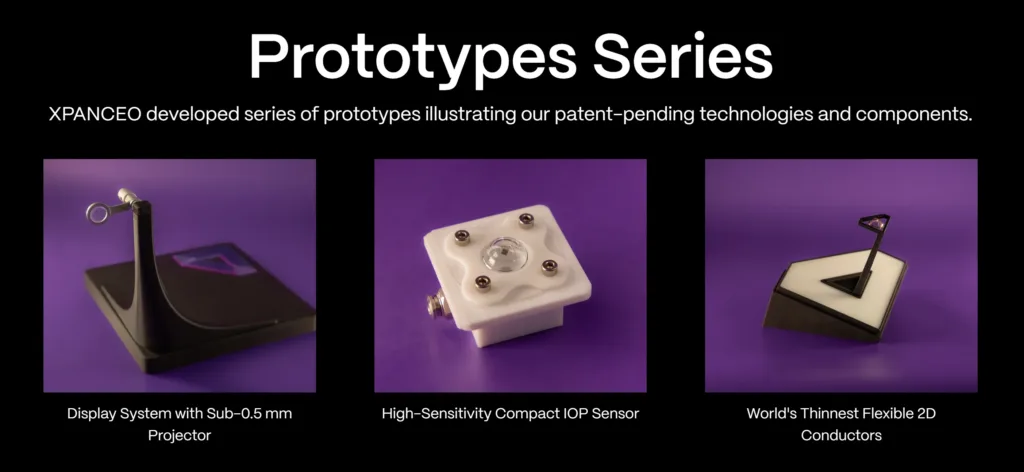Table of Contents
Xpanceo AI XR contact lens as one of the most ambitious ideas in advanced interface design. The Xpanceo AI XR contact lens project began in Dubai in 2021 under founder Roman Axelrod and physicist Valentyn Volkov. The team set out to build a contact lens that brings vision systems, biosensing tools, and AI XR contact lens capabilities into one device that sits directly on the eye. The goal goes far past simple projection. The goal aims to place artificial intelligence inside natural perception and remove the distance that screens create between people and digital tools.
How The Xpanceo AI XR Contact Lens Redefines The Next Interface
Major companies such as Apple, Meta, Google, and Samsung continue to develop AR glasses for wide AR access, yet the Xpanceo AI XR contact lens follows a more direct direction. Instead of adding another wearable screen, the Xpanceo AI XR contact lens places information in the human eye without heavy devices or visible displays. The founders want a device that can act as a digital extension of human senses. This idea guides every stage of their work.
How Xpanceo Built The AI XR Contact Lens Vision
Axelrod often describes the Xpanceo AI XR contact lens as a living space for intelligence. He explains that traditional screens form a gap between people and their tools. Even advanced AR glasses create separation. The Xpanceo AI XR contact lens aims to remove that separation and place the interface inside natural sensory input. Volkov supplies the material science knowledge that makes this vision possible. His long research background in nanophotonics gives him the experience to build atom thin optical layers that work inside a biological device.
Read more on our article of, RayNeo Air 4 HDR10 AR Glasses Redefine Augmented Reality with B&O Audio, published on October 29th 2025, SquaredTech.
The team behind the Xpanceo AI XR contact lens follows a direct engineering process. Over four years, they created more than twenty five prototypes. Each prototype solved one challenge at a time. The researchers tested display clarity, biosensing accuracy, power efficiency, material flexibility, and long term safety. The newest prototypes include an interactive micro display, sensors that track glucose and eye pressure, and a compact solid state battery. A small companion device worn on the body handles processing and power transfer that keeps the contact lens light and safe.
Technical Innovation Behind The Xpanceo AI XR Contact Lens

The Xpanceo AI XR contact lens works as a sensor and an interface at the same time. Because the lens sits directly on the eye, it avoids major issues that AR glasses face. It does not struggle with glare. It does not lose field of view. It delivers nearly complete optical efficiency. Volkov explains that with zero distance between the display and the eye, every unit of light reaches the retina. Power use drops by a large factor while the image stays sharp. This advantage gives the Xpanceo AI XR contact lens many possible uses that go far beyond digital overlays.
Medical use stands out as an early application. Doctors can use the Xpanceo AI XR contact lens to monitor glucose, eye pressure, and other health signals without bulky tools. Pilots and astronauts can use it to access flight or mission data without large helmets. Elite athletes can use it to track performance signals. In each case, the Xpanceo AI XR contact lens collects sensory data and passes it to AI models that interpret the data in real time. The lens then shows the results to the user through natural vision. This cycle shows how the Xpanceo AI XR contact lens enables direct communication between human senses and artificial intelligence.
Founders, Origins, And The Technology Culture That Shaped Xpanceo
The origins of the company explain how this idea formed. Axelrod grew up in a home where a parent worked as a computer engineer. He later entered robotics and esports. By his early thirties, he believed that screen based devices could no longer meet the needs of advanced systems. Long before AI became widely used, he imagined a device that could listen, observe, and reason with a user in natural perceptual space. He often compared the idea to the fictional assistant Jarvis, except in real form. Volkov had spent years studying two dimensional materials and had collaborated with Nobel laureate Konstantin Novoselov. His laboratory had the knowledge and equipment to attempt this type of interface. The mix of business instinct and scientific discipline allowed the team to turn a bold idea into a structured research path.
The Xpanceo laboratory in Dubai now employs one hundred researchers and engineers. About half hold PhDs. Nature Index lists the company as one of the top three physics startups worldwide. The company holds eighteen patent applications that include fifty seven inventions. In July 2025, the company raised two hundred fifty million dollars in Series A funding, reaching a one point three five billion dollar valuation. This was the largest funding round in AR VR wearables at that time. Xpanceo also declined at least two acquisition offers from major technology and medical firms, which shows clear confidence in its long term vision.
The Xpanceo AI XR Contact Lens Roadmap And Early Market Entry
The company plans to release medical and industrial versions of the Xpanceo AI XR contact lens first. These markets offer clear regulation paths and manageable production plans. Consumer models will come later once safety and manufacturing issues reach stable levels. One project with Italian medical firm Intra Ker already produced an intracorneal implant tested in a donor human eye. The device could restore vision by projecting images directly to the retina. This confirmed the core optical platform behind the Xpanceo AI XR contact lens. According to the team, the first complete prototype of the Xpanceo AI XR contact lens will appear by the end of 2026. The public debut will take place at a major global conference in early 2027.
Axelrod says each experiment moves the team closer to its larger mission. The Xpanceo AI XR contact lens will allow people to interact with an ambient layer of intelligence that assists them in daily tasks. The company wants AI to help users manage complex activities, improve health, and gain access to abilities that were not possible through past tools. The Xpanceo AI XR contact lens collects biological data, sends it to AI models in the cloud, and sends the results back through natural sight. The company continues to refine materials, optics, and flexible electronics at the atomic scale to push the lens toward a stable consumer product.
Why The Xpanceo AI XR Contact Lens May Succeed Where Others Failed
Industry analysts point out that attempts at smart contact lenses have failed in the past. Mojo Vision paused its project after spending more than one hundred million dollars. Manufacturing difficulty, strict regulation, and long term biocompatibility pose major challenges. Yet the Xpanceo AI XR contact lens shows visible progress that suggests a path forward. Even in prototype form, the technology shows how computing may shift in the future. Instead of living on desktops or separate devices, AI may move into direct sensory space.
Axelrod and Volkov call this shift the after glasses era. If the Xpanceo AI XR contact lens succeeds, people will not hold a device or wear a large frame. Instead, they will look through an intelligent interface that becomes part of their vision. In 2017, MIT Media Lab researcher Dr Patti Maes said that humans will eventually merge with their devices. The Xpanceo AI XR contact lens may prove that prediction correct.
SquaredTech sees the Xpanceo AI XR contact lens as a clear sign that the next interface may live inside human perception. If the team reaches its long term targets, the device may change how people experience data, health, work, and communication. The next chapter of computing may begin inside a small contact lens that places AI directly into vision.
Stay Updated: Gadgets


